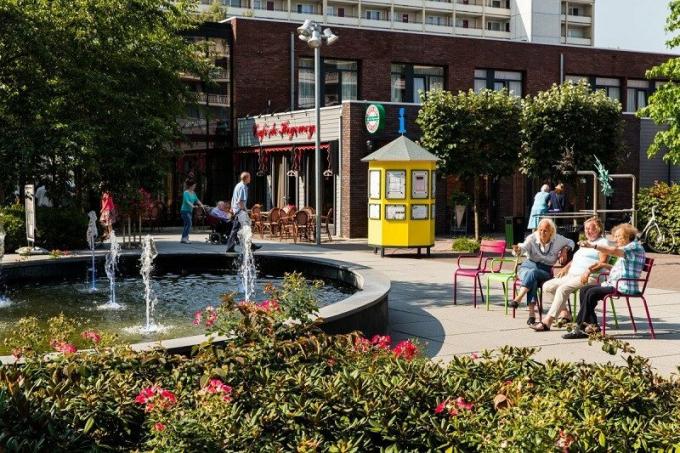What is Hogeweyk like, the town where elderly people with Dementia live?
Hogeweyk is located not far from Amsterdam, Netherlands. It is a small neighborhood that has everything necessary for a comfortable life: shops, bars, cinema, restaurants and hairdresser. Well, we could say to ourselves, what is interesting about this? It could be any neighborhood in any city in the world, right? Yes, if it weren't for all the inhabitants of Hogeweyk... suffer dementia.
The town is part of an experiment that began fourteen years ago and has shown that, in addition to being feasible, it is highly positive. Let's see it.
Hogeweyk: the neighborhood where all its inhabitants are elderly with dementia
The goal is for everyone in Hogeweyk to be able to live in a similar way to how they did before suffering from dementia. Each of them has a completely normal routine (breakfast, lunch, dinner, walks down the street, activities...). In other words, Hogeweyk aims to seek normality, so that its inhabitants feel free and autonomous. So, It has been proven that these people suffer less stress, are not as aggressive and their irritability decreases..

Hogeweyk's experiment is the result of the dissatisfaction caused by the situation of some people with dementia today: 85% are cared for by caregivers or family members at home; others are admitted to nursing homes. Thus, models like Hogeweyk's aim to investigate new solutions so that these people can enjoy the fullest life possible.
- Related article: "How to prevent cognitive decline?"
The importance of a normal life when you have dementia
It is common that, when faced with a case of dementia, the families of the affected person try to protect them. Thus, they tend to free it from routine occupations, which is highly harmful to the brain, which, like any muscle, deteriorates if it is not used.
As life expectancy has increased, the proportion of elderly people in the world has also increased, which implies that there will be more and more cases of people suffering from dementia. Currently, according to studies, around 20% of those over 85 years of age, as well as 40% of those over 90, suffer from dementia of some type. To care for these people and ensure their well-being, there must be environments in which feel comfortable, free and secure, even when they no longer have the capacity to recognize what is happening to them. surrounds
How does Hogeweyk, the town where elderly people with dementia live, work?
As we have mentioned, Hogeweyk is, at first glance, any neighborhood in Holland. People walk, go out for coffee, buy food, withdraw money from ATMs... However, all its inhabitants suffer from severe dementia, so Hogeweyk is actually a center for people with this particularity. The rest of the inhabitants (supermarket cashiers, waiters, etc.) are, in reality, people who have received instruction on how to take care of this type of people..
What is the difference with a residence? In them, the inmates live together, but precisely for this reason it does not look like a real home. In Hogeweyk people are divided into small groups (of about 6 or 7), so that coexistence is as close to a house as possible. Each patient is assigned a room, which they can decorate however they want, which makes it even more intimate, and Each of the cells of inhabitants is divided into neighborhoods, with the aim of making it as similar to a city as possible. normal. In addition, each of the neighborhoods is “personalized”, that is, it is equipped with distinctive landscapes, as well as specific reference points. On the other hand, leisure and shopping places are separated to encourage the movement of inhabitants.
The people who inhabit Hogeweyk have absolute freedom of movement; They can access all places safely, from private to public spaces. The living room of the apartments offers the possibility for these people to leave their rooms if they wish and socialize with their roommates. They can also go for a walk, of course, and chat with the other inhabitants. The basis is that they have decision-making capacity and, above all, autonomy, which has a positive impact on their quality of life. All of this, of course, with the greatest possible security.
Conclusions
Hogeweyk is not an isolated case. Since it opened in 2009, many other neighborhoods have opened around the world. Despite this, financing remains expensive and governments still do not participate in it, among other things. things because it has not been demonstrated with sufficient certainty that this model is better than the others, more conventional.
It seems significant that since Hogeweyk and the other models opened, the percentage of residents taking antipsychotic drugs has been cut in half.
Various studies support these “dementia villages”: Normal, routine life on a small scale reduces symptoms, as well as problematic behaviors of patients.. On the other hand, increasing lighting during the day reduced behavioral problems and orientation. spatial improved considerably, and the presence of gardens has a positive impact on the relaxation of the patients.
The “villa dementias”, due to their design, are a model that can work all over the world. People who suffer from dementia are human beings who, like everyone else, have aspirations and dreams, and they cannot be left abandoned in a chair until their last day arrives. They are people who want to remain active: shopping, having a coffee with their colleagues, chatting with their neighbors... all of this brings them well-being and happiness and considerably improves their quality of life. life.
What these types of neighborhoods cannot do is allow the person to remain in their familiar environment. Going to live in the “villa dementia” is a change, since it is not the usual place or the life that these people led before. They lose their friends and family and have to meet new people with the same problems, as well as their caregivers. All of this can be really traumatic and make the transition difficult.
In any case, the model on which Hogeweyk is based is a true reference in terms of care and well-being of older people with dementia. It has been awarded internationally and is increasingly exported to more countries, including Canada, Australia and Italy. Spain is, at the moment, one of the great absentees.


